Domain meetup: E-Healthcare #2
Download as pptx, pdf1 like90 views
This document discusses MAWI Solutions' ECG processing pipelines and their evolution from using traditional mathematical models to machine learning approaches. It provides an overview of how ECG signals work and are used in medicine. It then outlines the key steps in ECG processing - filtration, annotation, validation, and disease detection. For each step, it compares the traditional approaches using mathematical models to MAWI's newer machine learning-based approaches, providing examples of how deep learning algorithms can be applied to tasks like signal denoising, rhythm classification, and atrial fibrillation detection.
1 of 58
Download to read offline
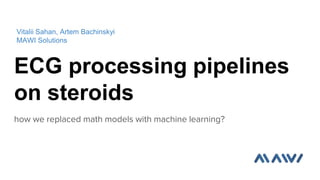
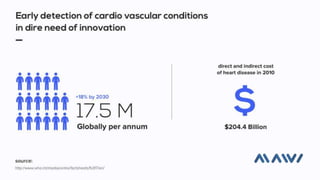
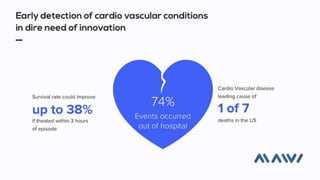
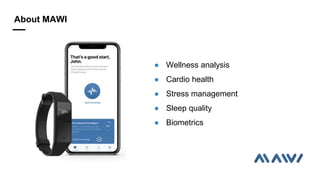
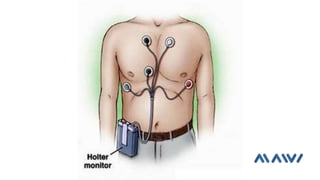

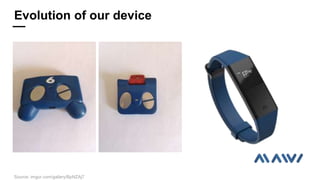


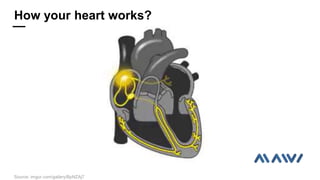
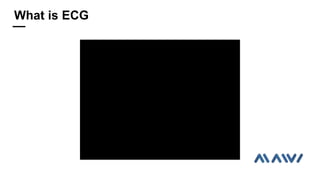


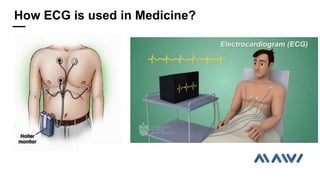
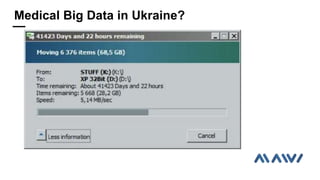


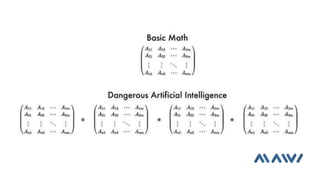
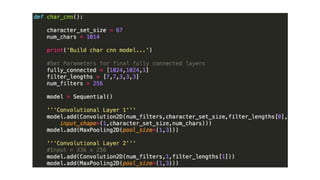
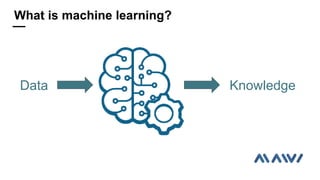

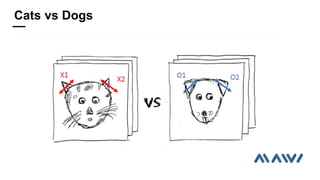
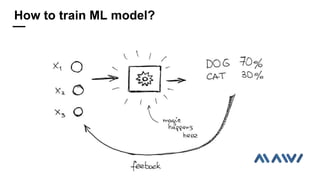



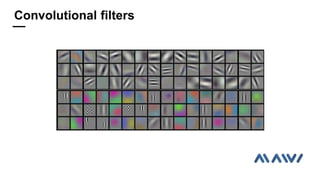

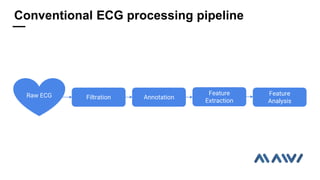


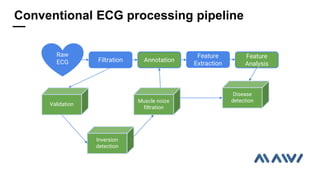

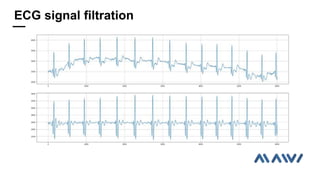
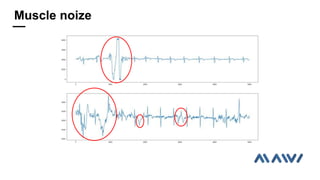
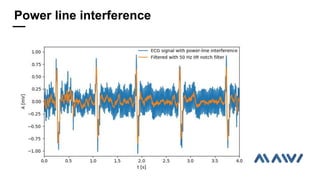
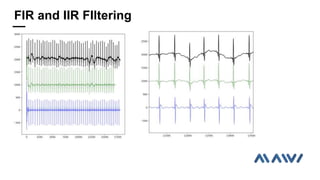
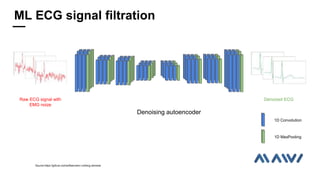


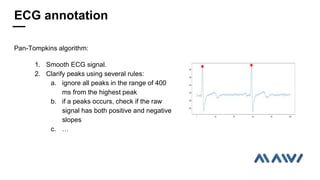







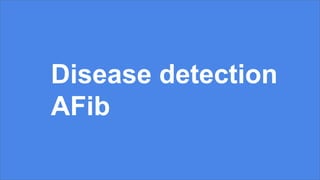

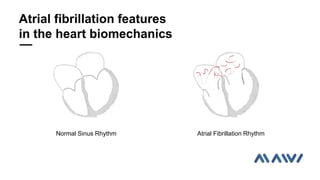
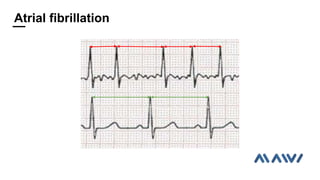
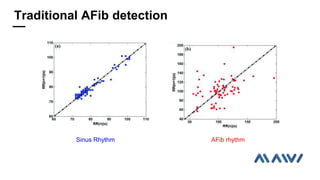

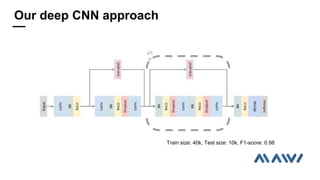

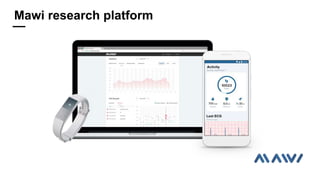

Ad
Recommended
DETECTION OF DISEASES USING ECG
DETECTION OF DISEASES USING ECGSerhat Da?
?
This document presents a final year project report on detecting diseases using electrocardiogram (ECG) signals. The project aims to design an algorithm that can automatically detect heart diseases by analyzing ECG signals. It uses a peak classification approach on the ECG signal to determine various diseases by analyzing the amplitude and duration of the P-Q-R-S-T peaks. The algorithm was implemented using MATLAB. It can detect bradycardia and tachycardia and has the potential to help physicians diagnose arrhythmias more easily and aid in medical education.Analysis and Classification of ECG Signal using Neural Network
Analysis and Classification of ECG Signal using Neural NetworkZHENG YAN LAM
?
This report describes an analysis and classification of electrocardiogram (ECG) signals using a neural network. The report includes:
1) An introduction to ECG signals, including acquisition and characteristics.
2) A description of neural network classification, including architectures like feedforward and feedback networks.
3) Details of experimental setup and methodology, including ECG preprocessing, feature extraction via wavelet decomposition, and a neural network classifier with a systematic data structure.
4) Results of two experiments on ECG classification, showing recognition rates of 80.89% and 93.75% respectively.
So in summary, the report presents a study using neural networks to classify ECG signals, with detailsCirculatory system 2
Circulatory system 2jpochne
?
The document discusses the cardiac cycle, its regulation through the electrocardiogram (ECG), and the structure and electrical activity of the heart. It examines what happens in each phase of the cardiac cycle and describes the ECG waves. Useful links are provided about reading EKGs, cardiac intervals, and electrocardiography.Classification of Arrhythmia from ECG Signals using MATLAB
Classification of Arrhythmia from ECG Signals using MATLABDr. Amarjeet Singh
?
This document discusses a method for classifying arrhythmia from ECG signals using MATLAB, achieving a 97% accuracy rate. It outlines the significance of ECG in detecting cardiac abnormalities, describing signal processing techniques and the classification of various arrhythmias. The paper also includes a comparative study of existing methods and highlights the use of morphological and dynamic features for improved classification outcomes.Ecg signal processing for detection and classification of cardiac diseases
Ecg signal processing for detection and classification of cardiac diseasesIAEME Publication
?
This document discusses ECG signal processing for detecting and classifying cardiac diseases. It begins with an overview of heart anatomy and the cardiac conduction system. It then discusses properties of cardiac muscle cells and ECG measurements. The main types of cardiac arrhythmias and diseases that can be detected from ECG signals are outlined, including ventricular fibrillation, atrial fibrillation, premature ventricular contractions, ischemia, and myocardial infarction. Detection methods focus on time-domain analysis of ECG signals using algorithms like Pan-Tompkins to identify arrhythmias, with results verified against databases like MIT-BIH and PhysioNet.Synthesizing ECG from PPG using GAN's
Synthesizing ECG from PPG using GAN'sSriSruthiChilukuri
?
The document presents a method called CardioGAN that uses a generative adversarial network to synthesize electrocardiogram (ECG) signals from photoplethysmogram (PPG) signals. CardioGAN uses an attention U-Net architecture for the generator and dual discriminators to classify signals in the time and frequency domains. It is trained in an unpaired manner on multiple ECG and PPG datasets. Evaluation shows it can successfully generate ECG signals from PPG inputs, though quality is reduced for highly noisy PPG inputs. The method has potential applications for continuous ECG monitoring using wearable devices.IRJET- Detection of Abnormal ECG Signal using DWT Feature Extraction and CNN
IRJET- Detection of Abnormal ECG Signal using DWT Feature Extraction and CNNIRJET Journal
?
This document discusses a study that uses discrete wavelet transform (DWT) to extract features from electrocardiogram (ECG) signals and then uses a convolutional neural network (CNN) to classify the signals as normal or abnormal. DWT is used to represent the ECG signals at different resolutions, which allows numerical features to be extracted. A CNN is then trained on the extracted features to predict whether signals indicate normal or abnormal heart conditions. The goal is to develop an efficient early detection system for cardiovascular disease by combining DWT feature extraction and CNN classification of ECG signals.Acquiring Ecg Signals And Analysing For Different Heart Ailments
Acquiring Ecg Signals And Analysing For Different Heart AilmentsIJERA Editor
?
This paper presents a system for acquiring and analyzing ECG signals to identify cardiac diseases using LabVIEW software, bridging the gap between engineering and medicine. The setup employs a microcontroller-based data acquisition system that collects and processes real-time ECG and phonocardiogram data, enabling disease diagnosis and automated reporting to physicians via email. The system includes a simplified three-lead electrode setup, signal conditioning, and a database to store patient information and results, aiming to streamline cardiac health monitoring.RCEP_Longer_Presentation
RCEP_Longer_PresentationJonah Kohen
?
This document describes the development of a Remote Cardiac Evaluation Platform (RCEP) which allows patients to get cardiac checkups remotely using a handheld device. The device measures ECG, pulse oximetry, and stethoscope data and transmits it via video conference to a doctor. The key challenges are sampling medical data fast enough, encrypting the data for security, and transmitting it wirelessly given bandwidth limitations of current standards like Bluetooth Low Energy. The device uses a Maxim microcontroller programmed in C to sample data from electrodes and encrypt it before sending over USB initially until wireless transmission can be properly configured.Fishing for Insights from Single-Lead and Multi-Lead ECG of Live Adult Zebrafish
Fishing for Insights from Single-Lead and Multi-Lead ECG of Live Adult ZebrafishInsideScientific
?
Dr. Thao P. Nguyen and her research team explore the use of zebrafish for studying human cardiac electrophysiology and arrhythmias, highlighting the similarities between human and zebrafish ECGs. The document covers the history, methodology, and applications of ECG recording in zebrafish, along with their implications for diagnosing arrhythmias and analyzing drug-induced cardiotoxicities. Key findings include the detailed steps for accurate ECG recording and the significance of dual-lead techniques in capturing zebrafish heart activity.Ecg.pptx
Ecg.pptxvinnukalyan1
?
An electrocardiogram (ECG) records the electrical activity of the heart. It is used to assess cardiac function, diagnose cardiac rhythm disorders and diseases, and evaluate the effects of treatment. The ECG procedure involves placing electrodes on the patient's limbs and chest to detect the heart's electrical impulses. The recording is then analyzed to determine the heart rhythm, conduction intervals, and any abnormalities in the QRS complexes, ST segments, or T waves.Electrocardiograph
Electrocardiographgoory
?
The document discusses electrocardiographs, which are devices that record the electrical activity of the heart in a graphical form called an electrocardiogram (ECG). ECGs are useful for checking heart rate, rhythm, and axis, and can detect conditions like enlargement of the heart or problems with heart muscle. Modern ECG devices are portable, allow self-monitoring, and can transmit readings to doctors for early detection of heart issues. Electrocardiographs analyze heart signal data and produce graphical outputs to help doctors identify potential heart problems.Electrocardiograph11
Electrocardiograph11goory
?
The document discusses electrocardiographs, which are devices that record the electrical activity of the heart in a graphical form called an electrocardiogram (ECG). ECGs are useful for checking heart rate, rhythm, and axis, and can detect conditions like enlargement of the heart or problems with heart muscle. Modern ECG devices are portable, allow self-monitoring, and can transmit readings to doctors for early detection of heart issues. Electrocardiographs analyze heart signal data and produce graphical outputs to help doctors identify potential heart problems.Ecg and other advantage
Ecg and other advantageMdAnowarKabir3
?
ECG data is collected using an ECG sensor and machine to record the electrical signals of the heart. The ECG sensor consists of electrodes placed on the chest to detect the heart's electrical activity through different phases represented by the P, Q, R, S, and T waves in the ECG curve. Abnormalities in the ECG curve can help doctors diagnose heart conditions like blocked arteries. The ECG is a quick, painless test that provides important data to assess heart health and detect potential issues.Chapter 5 - Making Sense of the 12 Lead
Chapter 5 - Making Sense of the 12 Leadryanhall911
?
This document is a chapter from the Ontario Base Hospital Group about interpreting 12-lead electrocardiograms (ECGs). It discusses the standard ECG printout format and how it relates to time. It also describes the benefits and limitations of machine analysis, how to locate the isoelectric line for voltage measurements, and how to validate a 12-lead ECG by checking for normal wave progression and looking for signs of lead reversals. The overall aim is to help acute care providers accurately interpret ECGs.Valais 36
Valais 36Saurabh1106016
?
The document describes the design and construction of a prototype electrocardiogram (ECG) simulator. The ECG simulator generates electrical signals that mimic human heart rhythms to test the reliability and diagnostic capabilities of ECG recorders. It produces normal and abnormal heart rhythms at various beat rates and can simulate 12-lead ECG recordings. The device uses analog circuitry and a microcontroller to generate ECG waveforms that are comparable to real human ECG recordings. It provides a means to calibrate and test ECG recorders.Classification and Detection of ECG-signals using Artificial Neural Networks
Classification and Detection of ECG-signals using Artificial Neural NetworksGaurav upadhyay
?
The document discusses the use of electrocardiogram (ECG) as a noninvasive diagnostic tool for cardiovascular diseases, focusing on the automatic detection of cardiac arrhythmias using a combination of digital signal processing and pattern recognition techniques. It describes the methodology for detecting QRS complexes, feature extraction from beats, and heartbeat classification to identify arrhythmias, employing MATLAB for implementation and utilizing the MIT-BIH arrhythmias database for performance evaluation. The project aims to facilitate timely analysis of ECG signals in clinical settings, enhancing diagnostic efficiency for conditions such as bradycardia and tachycardia.Electrical mapping of the heart
Electrical mapping of the heartFelix Obi
?
The document discusses the process of electrical mapping of the heart, which is used to diagnose arrhythmias using catheterization to map electrical activity in heart chambers. It outlines the historical development of mapping techniques, including noninvasive, epicardial, and endocardial methods, as well as specific mapping systems like Carto and Ensite. The conclusion emphasizes the advancements in 3D mapping technologies that improve visualization and accuracy of intracardiac catheter localization.PPT 1.pptx
PPT 1.pptxajax301
?
This document provides an introduction to biomedical signals and biomedical signal processing. It discusses what biomedical signals are, examples of biomedical signals like ECG and EEG, the steps involved in biomedical signal data acquisition and processing, and some of the challenges in data acquisition. The document is presented by two students and supervised by two professors from the University of Calcutta. It contains 13 sections covering topics like what a signal and biomedical signal are, biomedical signal acquisition techniques for ECG and PPG, challenges in acquisition like artifacts, and an overview of signal processing steps like feature extraction and classification.Project
Projectmina medhat
?
The document outlines the development of an IoT-cloud based ECG monitoring system for elderly patient healthcare, focusing on biomedical and machine learning techniques for arrhythmia detection. It details hardware components, including an ECG sensor and Bluetooth module, and describes the cloud infrastructure utilizing services like Firebase and AWS for real-time data processing and storage. The system aims to provide efficient remote monitoring and analysis, improving healthcare access for patients unable to navigate modern technology.Af4103186190
Af4103186190IJERA Editor
?
This research article discusses the analysis of ECG signals using a filter bank approach to detect arrhythmias, highlighting the challenges caused by noise such as power line interference. An adaptive LMS notch filter is employed to effectively remove such noise, followed by low-pass filtering and a filter bank to enhance QRS complex detection. The results demonstrate the improved clarity of the ECG signals post-processing, with successful identification of R-peaks.ppt_Cardiovascular Diseases Prediction from ECG images.pptx
ppt_Cardiovascular Diseases Prediction from ECG images.pptxNahidHasan424311
?
This document describes a proposed system to predict cardiovascular disease from ECG images using machine learning. The system would digitize and preprocess ECG images, extract feature data, train an ensemble machine learning model, and provide instant disease predictions through a web application. Benefits include accessibility in remote areas and speeding up the diagnosis process, though results may not be 100% accurate due to limited image data. The system is intended to supplement rather than replace the existing process.Cardio Logical Signal Processing for Arrhythmia Detection with Comparative An...
Cardio Logical Signal Processing for Arrhythmia Detection with Comparative An...IRJET Journal
?
This document summarizes research on detecting cardiac arrhythmias by analyzing electrocardiogram (ECG) signals. ECG signals are often contaminated with power line interference that must be removed using a notch filter before features can be extracted. The researchers compare the impact of different Q-factor values for the notch filter on the QRS complex of the ECG. They detect the QRS complex using difference operation method and then calculate features of the R-peak like sharpness and slope. A linear classifier is then used to classify signals as normal or arrhythmic based on these features.Identification of Myocardial Infarction from Multi-Lead ECG signal
Identification of Myocardial Infarction from Multi-Lead ECG signalIJERA Editor
?
The document discusses the identification of myocardial infarction using multi-lead ECG signals, emphasizing the importance of preprocessing to remove noise for better classification accuracy. It employs principal component analysis for feature extraction and a point scoring system to enhance diagnosis sensitivity, achieving a sensitivity of 94% in distinguishing between normal and myocardial infarction ECG signals. The study highlights the utility of multi-lead ECGs in improving cardiovascular diagnostics.ppt_Cardiovascular Diseases Prediction from ECG images.pdf
ppt_Cardiovascular Diseases Prediction from ECG images.pdfNahidHasan509001
?
This document describes a proposed system to predict cardiovascular disease from ECG images using machine learning. The system preprocesses ECG images by converting them to grayscale, resizing, extracting 12 lead values, and removing gridlines. Data features are extracted using contour techniques and normalization. Multiple machine learning algorithms are tested and ensemble techniques are used to classify ECG images into normal, myocardial infarction, abnormal heartbeat, or history of myocardial infarction categories. The proposed system aims to provide instant results without doctor visits for initial diagnosis to help speed up the diagnosis process, though it may not be 100% accurate with limited data. A deployment architecture and demo website are presented.ECG
ECGSuraj Shandilya
?
The document discusses the electrocardiogram (ECG), which measures and records the electrical activity of the heart. An ECG represents the atrial and ventricular depolarization and repolarization that occurs with each heartbeat. ECGs are obtained via electrodes placed on the skin and measure the potential differences. The ECG signal is analyzed in both the time and frequency domains to study cardiac features. A typical ECG consists of P, Q, R, S, and T waves that represent different electrical events in the heart. Digital signal processing is used to filter noise and detect the heart rate from the ECG signal.arrythmia------.pptx ohmikomokmlhkmjgkgg
arrythmia------.pptx ohmikomokmlhkmjgkgggreypuma48
?
The document outlines a project focused on developing an ECG analysis algorithm for arrhythmia classification to improve diagnostic capabilities and facilitate real-time analysis. It details objectives such as reliable data handling, compliance with healthcare standards, and the incorporation of continuous improvement mechanisms. The methodology includes data collection, feature extraction, and model training using advanced algorithms, with results indicating high accuracy in classifying various arrhythmia conditions.Less computational approach to detect QRS complexes in ECG rhythms
Less computational approach to detect QRS complexes in ECG rhythmsCSITiaesprime
?
This document presents a study on the automatic detection of QRS complexes in ECG signals using a less computational approach. The proposed algorithm employs a series of filtering techniques¡ªsingle low-pass, difference, and moving average filters¡ªfollowed by an adaptive threshold to enhance detection accuracy amid noise. Results confirm the algorithm's effectiveness in identifying QRS complexes with varying sensitivity across different ECG signals.Intelligent Heart Disease Recognition using Neural Networks
Intelligent Heart Disease Recognition using Neural NetworksIEEEP Karachi
?
This document summarizes a research project on intelligent heart disease recognition using neural networks. The researchers developed a system to automatically analyze electrocardiogram (ECG) signals, detect cardiac abnormalities without requiring a cardiologist, and remotely diagnose patients. They extracted morphological and statistical features from ECG data and used a neural network classifier with 23 input nodes, 6 output nodes, and 5 hidden nodes. After training on 100 samples, the network achieved an average recognition rate of 90.6% across 6 heart conditions on a separate test set of 100 samples. The researchers concluded the method showed potential but could be improved by expanding it to more cardiac conditions and larger datasets.Ecg123 (1)
Ecg123 (1)Himanshu Gawande
?
The document provides a comprehensive overview of electrocardiogram (ECG) as a technique for recording bioelectric currents generated by the heart to assess its functionality and diagnose various conditions. It details the principles of ECG, the importance of amplifiers for signal interpretation, and the filtering techniques required to enhance signal quality amidst noise. Additionally, it discusses the applications, limitations, and the vital role of the heart in overall health monitoring.More Related Content
What's hot (10)
RCEP_Longer_Presentation
RCEP_Longer_PresentationJonah Kohen
?
This document describes the development of a Remote Cardiac Evaluation Platform (RCEP) which allows patients to get cardiac checkups remotely using a handheld device. The device measures ECG, pulse oximetry, and stethoscope data and transmits it via video conference to a doctor. The key challenges are sampling medical data fast enough, encrypting the data for security, and transmitting it wirelessly given bandwidth limitations of current standards like Bluetooth Low Energy. The device uses a Maxim microcontroller programmed in C to sample data from electrodes and encrypt it before sending over USB initially until wireless transmission can be properly configured.Fishing for Insights from Single-Lead and Multi-Lead ECG of Live Adult Zebrafish
Fishing for Insights from Single-Lead and Multi-Lead ECG of Live Adult ZebrafishInsideScientific
?
Dr. Thao P. Nguyen and her research team explore the use of zebrafish for studying human cardiac electrophysiology and arrhythmias, highlighting the similarities between human and zebrafish ECGs. The document covers the history, methodology, and applications of ECG recording in zebrafish, along with their implications for diagnosing arrhythmias and analyzing drug-induced cardiotoxicities. Key findings include the detailed steps for accurate ECG recording and the significance of dual-lead techniques in capturing zebrafish heart activity.Ecg.pptx
Ecg.pptxvinnukalyan1
?
An electrocardiogram (ECG) records the electrical activity of the heart. It is used to assess cardiac function, diagnose cardiac rhythm disorders and diseases, and evaluate the effects of treatment. The ECG procedure involves placing electrodes on the patient's limbs and chest to detect the heart's electrical impulses. The recording is then analyzed to determine the heart rhythm, conduction intervals, and any abnormalities in the QRS complexes, ST segments, or T waves.Electrocardiograph
Electrocardiographgoory
?
The document discusses electrocardiographs, which are devices that record the electrical activity of the heart in a graphical form called an electrocardiogram (ECG). ECGs are useful for checking heart rate, rhythm, and axis, and can detect conditions like enlargement of the heart or problems with heart muscle. Modern ECG devices are portable, allow self-monitoring, and can transmit readings to doctors for early detection of heart issues. Electrocardiographs analyze heart signal data and produce graphical outputs to help doctors identify potential heart problems.Electrocardiograph11
Electrocardiograph11goory
?
The document discusses electrocardiographs, which are devices that record the electrical activity of the heart in a graphical form called an electrocardiogram (ECG). ECGs are useful for checking heart rate, rhythm, and axis, and can detect conditions like enlargement of the heart or problems with heart muscle. Modern ECG devices are portable, allow self-monitoring, and can transmit readings to doctors for early detection of heart issues. Electrocardiographs analyze heart signal data and produce graphical outputs to help doctors identify potential heart problems.Ecg and other advantage
Ecg and other advantageMdAnowarKabir3
?
ECG data is collected using an ECG sensor and machine to record the electrical signals of the heart. The ECG sensor consists of electrodes placed on the chest to detect the heart's electrical activity through different phases represented by the P, Q, R, S, and T waves in the ECG curve. Abnormalities in the ECG curve can help doctors diagnose heart conditions like blocked arteries. The ECG is a quick, painless test that provides important data to assess heart health and detect potential issues.Chapter 5 - Making Sense of the 12 Lead
Chapter 5 - Making Sense of the 12 Leadryanhall911
?
This document is a chapter from the Ontario Base Hospital Group about interpreting 12-lead electrocardiograms (ECGs). It discusses the standard ECG printout format and how it relates to time. It also describes the benefits and limitations of machine analysis, how to locate the isoelectric line for voltage measurements, and how to validate a 12-lead ECG by checking for normal wave progression and looking for signs of lead reversals. The overall aim is to help acute care providers accurately interpret ECGs.Valais 36
Valais 36Saurabh1106016
?
The document describes the design and construction of a prototype electrocardiogram (ECG) simulator. The ECG simulator generates electrical signals that mimic human heart rhythms to test the reliability and diagnostic capabilities of ECG recorders. It produces normal and abnormal heart rhythms at various beat rates and can simulate 12-lead ECG recordings. The device uses analog circuitry and a microcontroller to generate ECG waveforms that are comparable to real human ECG recordings. It provides a means to calibrate and test ECG recorders.Classification and Detection of ECG-signals using Artificial Neural Networks
Classification and Detection of ECG-signals using Artificial Neural NetworksGaurav upadhyay
?
The document discusses the use of electrocardiogram (ECG) as a noninvasive diagnostic tool for cardiovascular diseases, focusing on the automatic detection of cardiac arrhythmias using a combination of digital signal processing and pattern recognition techniques. It describes the methodology for detecting QRS complexes, feature extraction from beats, and heartbeat classification to identify arrhythmias, employing MATLAB for implementation and utilizing the MIT-BIH arrhythmias database for performance evaluation. The project aims to facilitate timely analysis of ECG signals in clinical settings, enhancing diagnostic efficiency for conditions such as bradycardia and tachycardia.Electrical mapping of the heart
Electrical mapping of the heartFelix Obi
?
The document discusses the process of electrical mapping of the heart, which is used to diagnose arrhythmias using catheterization to map electrical activity in heart chambers. It outlines the historical development of mapping techniques, including noninvasive, epicardial, and endocardial methods, as well as specific mapping systems like Carto and Ensite. The conclusion emphasizes the advancements in 3D mapping technologies that improve visualization and accuracy of intracardiac catheter localization.Similar to Domain meetup: E-Healthcare #2 (20)
PPT 1.pptx
PPT 1.pptxajax301
?
This document provides an introduction to biomedical signals and biomedical signal processing. It discusses what biomedical signals are, examples of biomedical signals like ECG and EEG, the steps involved in biomedical signal data acquisition and processing, and some of the challenges in data acquisition. The document is presented by two students and supervised by two professors from the University of Calcutta. It contains 13 sections covering topics like what a signal and biomedical signal are, biomedical signal acquisition techniques for ECG and PPG, challenges in acquisition like artifacts, and an overview of signal processing steps like feature extraction and classification.Project
Projectmina medhat
?
The document outlines the development of an IoT-cloud based ECG monitoring system for elderly patient healthcare, focusing on biomedical and machine learning techniques for arrhythmia detection. It details hardware components, including an ECG sensor and Bluetooth module, and describes the cloud infrastructure utilizing services like Firebase and AWS for real-time data processing and storage. The system aims to provide efficient remote monitoring and analysis, improving healthcare access for patients unable to navigate modern technology.Af4103186190
Af4103186190IJERA Editor
?
This research article discusses the analysis of ECG signals using a filter bank approach to detect arrhythmias, highlighting the challenges caused by noise such as power line interference. An adaptive LMS notch filter is employed to effectively remove such noise, followed by low-pass filtering and a filter bank to enhance QRS complex detection. The results demonstrate the improved clarity of the ECG signals post-processing, with successful identification of R-peaks.ppt_Cardiovascular Diseases Prediction from ECG images.pptx
ppt_Cardiovascular Diseases Prediction from ECG images.pptxNahidHasan424311
?
This document describes a proposed system to predict cardiovascular disease from ECG images using machine learning. The system would digitize and preprocess ECG images, extract feature data, train an ensemble machine learning model, and provide instant disease predictions through a web application. Benefits include accessibility in remote areas and speeding up the diagnosis process, though results may not be 100% accurate due to limited image data. The system is intended to supplement rather than replace the existing process.Cardio Logical Signal Processing for Arrhythmia Detection with Comparative An...
Cardio Logical Signal Processing for Arrhythmia Detection with Comparative An...IRJET Journal
?
This document summarizes research on detecting cardiac arrhythmias by analyzing electrocardiogram (ECG) signals. ECG signals are often contaminated with power line interference that must be removed using a notch filter before features can be extracted. The researchers compare the impact of different Q-factor values for the notch filter on the QRS complex of the ECG. They detect the QRS complex using difference operation method and then calculate features of the R-peak like sharpness and slope. A linear classifier is then used to classify signals as normal or arrhythmic based on these features.Identification of Myocardial Infarction from Multi-Lead ECG signal
Identification of Myocardial Infarction from Multi-Lead ECG signalIJERA Editor
?
The document discusses the identification of myocardial infarction using multi-lead ECG signals, emphasizing the importance of preprocessing to remove noise for better classification accuracy. It employs principal component analysis for feature extraction and a point scoring system to enhance diagnosis sensitivity, achieving a sensitivity of 94% in distinguishing between normal and myocardial infarction ECG signals. The study highlights the utility of multi-lead ECGs in improving cardiovascular diagnostics.ppt_Cardiovascular Diseases Prediction from ECG images.pdf
ppt_Cardiovascular Diseases Prediction from ECG images.pdfNahidHasan509001
?
This document describes a proposed system to predict cardiovascular disease from ECG images using machine learning. The system preprocesses ECG images by converting them to grayscale, resizing, extracting 12 lead values, and removing gridlines. Data features are extracted using contour techniques and normalization. Multiple machine learning algorithms are tested and ensemble techniques are used to classify ECG images into normal, myocardial infarction, abnormal heartbeat, or history of myocardial infarction categories. The proposed system aims to provide instant results without doctor visits for initial diagnosis to help speed up the diagnosis process, though it may not be 100% accurate with limited data. A deployment architecture and demo website are presented.ECG
ECGSuraj Shandilya
?
The document discusses the electrocardiogram (ECG), which measures and records the electrical activity of the heart. An ECG represents the atrial and ventricular depolarization and repolarization that occurs with each heartbeat. ECGs are obtained via electrodes placed on the skin and measure the potential differences. The ECG signal is analyzed in both the time and frequency domains to study cardiac features. A typical ECG consists of P, Q, R, S, and T waves that represent different electrical events in the heart. Digital signal processing is used to filter noise and detect the heart rate from the ECG signal.arrythmia------.pptx ohmikomokmlhkmjgkgg
arrythmia------.pptx ohmikomokmlhkmjgkgggreypuma48
?
The document outlines a project focused on developing an ECG analysis algorithm for arrhythmia classification to improve diagnostic capabilities and facilitate real-time analysis. It details objectives such as reliable data handling, compliance with healthcare standards, and the incorporation of continuous improvement mechanisms. The methodology includes data collection, feature extraction, and model training using advanced algorithms, with results indicating high accuracy in classifying various arrhythmia conditions.Less computational approach to detect QRS complexes in ECG rhythms
Less computational approach to detect QRS complexes in ECG rhythmsCSITiaesprime
?
This document presents a study on the automatic detection of QRS complexes in ECG signals using a less computational approach. The proposed algorithm employs a series of filtering techniques¡ªsingle low-pass, difference, and moving average filters¡ªfollowed by an adaptive threshold to enhance detection accuracy amid noise. Results confirm the algorithm's effectiveness in identifying QRS complexes with varying sensitivity across different ECG signals.Intelligent Heart Disease Recognition using Neural Networks
Intelligent Heart Disease Recognition using Neural NetworksIEEEP Karachi
?
This document summarizes a research project on intelligent heart disease recognition using neural networks. The researchers developed a system to automatically analyze electrocardiogram (ECG) signals, detect cardiac abnormalities without requiring a cardiologist, and remotely diagnose patients. They extracted morphological and statistical features from ECG data and used a neural network classifier with 23 input nodes, 6 output nodes, and 5 hidden nodes. After training on 100 samples, the network achieved an average recognition rate of 90.6% across 6 heart conditions on a separate test set of 100 samples. The researchers concluded the method showed potential but could be improved by expanding it to more cardiac conditions and larger datasets.Ecg123 (1)
Ecg123 (1)Himanshu Gawande
?
The document provides a comprehensive overview of electrocardiogram (ECG) as a technique for recording bioelectric currents generated by the heart to assess its functionality and diagnose various conditions. It details the principles of ECG, the importance of amplifiers for signal interpretation, and the filtering techniques required to enhance signal quality amidst noise. Additionally, it discusses the applications, limitations, and the vital role of the heart in overall health monitoring.VISHAV snp.pptx
VISHAV snp.pptxNeerajBhatt62
?
The document discusses the development of an adaptive noise canceller filter in MATLAB for electrocardiogram (ECG) signal analysis, focusing on various methodologies including band-pass filtering, adaptive filtering, and QRS detection using the Pan-Tompkins algorithm. It details the implementation of different filter types to enhance signal quality by eliminating noise and ensuring accurate detection of heart activity. The methodology aims to facilitate better clinical diagnosis by providing a more reliable ECG signal interpretation.Fpga based arrhythmia detection resume
Fpga based arrhythmia detection resumeAlvi Milanisti
?
This document summarizes a proposed FPGA-based ECG analysis system for arrhythmia detection. The system uses empirical mode decomposition (EMD) for ECG signal preprocessing to remove noise. EMD decomposes the noisy ECG signal into intrinsic mode functions (IMFs) and spectral flatness is used to identify noisy IMFs. After enhancement, R peak detection is performed using a threshold to extract heart rate for arrhythmia detection. The design was implemented on an FPGA board using Verilog and was able to detect arrhythmias through LEDs while using a small portion of the FPGA's resources.Novel method to find the parameter for noise removal from multi channel ecg w...
Novel method to find the parameter for noise removal from multi channel ecg w...eSAT Journals
?
This document presents a novel method for removing noise from multi-channel electrocardiogram (ECG) waveforms using a multi-swarm optimization (MSO) approach. The method involves extracting features from ECG data, using MSO to identify an optimal cutoff frequency parameter for a finite impulse response (FIR) filter, and applying the FIR filter using the identified parameter to remove noise from the ECG signals. The MSO approach divides particles into multiple swarms that each focus on a region of the search space, helping to overcome sensitivity to initial positions found in traditional particle swarm optimization. The resulting filtered ECG signals are evaluated against original clean signals to validate the noise removal performance of the MSO-identified cutoff frequency parameter andNovel method to find the parameter for noise removal
Novel method to find the parameter for noise removaleSAT Publishing House
?
The document presents a novel approach using Multi-Swarm Optimization (MSO) for efficiently determining the cut-off frequency parameters necessary for noise removal from multi-channel electrocardiogram (ECG) waveforms. It emphasizes that traditional methods struggle with the complexities of dynamic multi-channel ECGs and that FIR filters, enhanced by MSO, provide a more effective solution for achieving clear ECG signals. The study involves testing data from various ECG databases to demonstrate the methodology's effectiveness in removing noise while preserving critical cardiac information.ECG Signal Denoising using Digital Filter and Adaptive Filter
ECG Signal Denoising using Digital Filter and Adaptive FilterIRJET Journal
?
1. The document discusses methods for denoising electrocardiogram (ECG) signals, including digital filters and adaptive filters.
2. It evaluates the performance of Savitzky-Golay filters, band pass filters, and adaptive noise cancellation techniques for removing noise from ECG signals and improving the signal-to-noise ratio.
3. The key filters discussed are Savitzky-Golay filters, Tompkins filters, Butterworth band pass filters, and least mean square adaptive filters, analyzing their ability to reduce noise like powerline interference, baseline drift, and motion artifacts from ECG data.QRS detection is important in all kinds of ECG signal processing
QRS detection is important in all kinds of ECG signal processingshohel rana
?
QRS detection is crucial for ECG signal processing, requiring detectors to handle various QRS morphologies and noise issues. The typical detector algorithm encompasses preprocessing with linear and nonlinear methods followed by a decision rule to determine QRS presence. Performance evaluation is necessary to optimize parameter settings and ensure effective detection across diverse ECG recordings and conditions.Non-Invasive point of care ECG signal detection and analytics for cardiac dis...
Non-Invasive point of care ECG signal detection and analytics for cardiac dis...gptshubham
?
This document describes a project to develop a portable, non-invasive device for point-of-care ECG monitoring and cardiac disease detection. The goals are to analyze existing ECG devices, develop a micropatterned electrode system, refine an ECG dataset, build and train a convolutional neural network model to classify heart rhythms, and create a prototype circuit. The model achieves 81.36% accuracy on the test data. Challenges include sourcing hardware components and refining the electrode interface. Future work involves completing the circuit prototype and integrating online prediction via a cloud-based model.Noise removal using_ecg
Noise removal using_ecgLora Sahoo
?
This document discusses an project on removing noise from electrocardiogram (ECG) signals using adaptive and Savitzky-Golay filters. It involves capturing a simulated ECG signal, adding artificially generated noise, and then filtering the noisy signal using an adaptive filter followed by a Savitzky-Golay filter to produce a cleaned output waveform. The goal is to extract clinically useful information from noisy ECG data for diagnosing cardiovascular conditions.Ad
Recently uploaded (20)
Ageing Popualtion: Global Issue
Ageing Popualtion: Global Issuekenipoopoo
?
This presentation is about the growing number of older people in the world and why it¡¯s important to pay attention to it. It explains that ageing happens because our bodies go through damage over time, which leads to problems with our health. Some key facts show that by 2050, a huge part of the population will be over 60 years old, especially in low- and middle-income countries. It highlights common health problems that come with age. It talks about ways we can respond to the increasing ageing population (pushing for beneficial policies, not engaging in ageism, and expanding healthcare access). ×îаæÃÀ¹ú¼ÓÀû¸£ÄáÑÇÖÝÁ¢´óѧÌØÂå¿Ë·ÖУ±ÏÒµÖ¤£¨°ä³§±«³§±ÏÒµÖ¤Ê飩԰涨ÖÆ
×îаæÃÀ¹ú¼ÓÀû¸£ÄáÑÇÖÝÁ¢´óѧÌØÂå¿Ë·ÖУ±ÏÒµÖ¤£¨°ä³§±«³§±ÏÒµÖ¤Ê飩԰涨ÖÆtaqyea
?
Ò»±ÈÒ»»¹Ô¼ÓÀû¸£ÄáÑÇÖÝÁ¢´óѧÌØÂå¿Ë·ÖУ±ÏÒµÖ¤/CSU Stanislaus±ÏÒµÖ¤Êé2025԰桾qÞ±1954292140¡¿ÎÒÃÇרҵ°ìÀí°ÄÖÞ´óѧ±ÏÒµÖ¤³É¼¨µ¥£¬ÃÀ¹ú´óѧ±ÏÒµÖ¤³É¼¨µ¥,Ó¢¹ú´óѧ±ÏÒµÖ¤³É¼¨µ¥£¬¼ÓÄôó´óѧ±ÏÒµÖ¤³É¼¨µ¥£¬Ð¼ÓÆ´óѧ±ÏÒµÖ¤³É¼¨µ¥£¬ÐÂÎ÷À¼´óѧ±ÏÒµÖ¤³É¼¨µ¥£¬º«¹ú´óѧ±ÏÒµÖ¤³É¼¨µ¥£¬ÈÕ±¾´óѧ±ÏÒµÖ¤³É¼¨µ¥¡£
¡¾¸´¿ÌÒ»Ì×¼ÓÀû¸£ÄáÑÇÖÝÁ¢´óѧÌØÂå¿Ë·ÖУ±ÏÒµÖ¤³É¼¨µ¥ÐÅ·âµÈ²ÄÁÏ×îÇ¿¹¥ÂÔ,Buy California State University, Stanislaus Transcripts¡¿
¹ºÂòÈÕº«³É¼¨µ¥¡¢Ó¢¹ú´óѧ³É¼¨µ¥¡¢ÃÀ¹ú´óѧ³É¼¨µ¥¡¢°ÄÖÞ´óѧ³É¼¨µ¥¡¢¼ÓÄôó´óѧ³É¼¨µ¥£¨q΢1954292140£©Ð¼ÓÆ´óѧ³É¼¨µ¥¡¢ÐÂÎ÷À¼´óѧ³É¼¨µ¥¡¢°®¶ûÀ¼³É¼¨µ¥¡¢Î÷°àÑÀ³É¼¨µ¥¡¢µÂ¹ú³É¼¨µ¥¡£³É¼¨µ¥µÄÒâÒåÖ÷ÒªÌåÏÖÔÚÖ¤Ã÷ѧϰÄÜÁ¦¡¢ÆÀ¹ÀѧÊõ±³¾°¡¢Õ¹Ê¾×ÛºÏËØÖÊ¡¢Ìá¸ß¼ȡÂÊ£¬ÒÔ¼°ÊÇ×÷ΪÁôÐÅÈÏÖ¤ÉêÇë²ÄÁϵÄÒ»²¿·Ö¡£
¼ÓÀû¸£ÄáÑÇÖÝÁ¢´óѧÌØÂå¿Ë·ÖУ³É¼¨µ¥Äܹ»ÌåÏÖÄúµÄµÄѧϰÄÜÁ¦£¬°üÀ¨¼ÓÀû¸£ÄáÑÇÖÝÁ¢´óѧÌØÂå¿Ë·ÖУ¿Î³Ì³É¼¨¡¢×¨ÒµÄÜÁ¦¡¢Ñо¿ÄÜÁ¦¡££¨q΢1954292140£©¾ßÌåÀ´Ëµ£¬³É¼¨±¨¸æµ¥Í¨³£°üº¬Ñ§ÉúµÄѧϰ¼¼ÄÜÓëÏ°¹ß¡¢¸÷¿Æ³É¼¨ÒÔ¼°ÀÏʦÆÀÓïµÈ²¿·Ö£¬Òò´Ë£¬³É¼¨µ¥²»½öÊÇѧÉúѧÊõÄÜÁ¦µÄÖ¤Ã÷£¬Ò²ÊÇÆÀ¹ÀѧÉúÊÇ·ñÊʺÏij¸ö½ÌÓýÏîÄ¿µÄÖØÒªÒÀ¾Ý£¡
ÎÒÃdzÐŵ²ÉÓõÄÊÇѧУ԰æÖ½ÕÅ£¨Ô°æÖ½ÖÊ¡¢µ×É«¡¢ÎÆ·£©ÎÒÃǹ¤³§ÓµÓÐÈ«Ì×½ø¿ÚÔ×°É豸£¬ÌØÊ⹤ÒÕ¶¼ÊDzÉÓò»Í¬»úÆ÷ÖÆ×÷£¬·ÂÕæ¶È»ù±¾¿ÉÒÔ´ïµ½100%£¬ËùÓгÉÆ·ÒÔ¼°¹¤ÒÕЧ¹û¶¼¿ÉÌáÇ°¸ø¿Í»§Õ¹Ê¾£¬²»ÂúÒâ¿ÉÒÔ¸ù¾Ý¿Í»§ÒªÇó½øÐе÷Õû£¬Ö±µ½ÂúÒâΪֹ£¡
¡¾Ö÷ÓªÏîÄ¿¡¿
Ò»¡¢¹¤×÷δȷ¶¨£¬»Ø¹úÐèÏȸø¸¸Ä¸¡¢Ç×ÆÝÅóÓÑ¿´ÏÂÎÄƾµÄÇé¿ö£¬°ìÀí±ÏÒµÖ¤|°ìÀíÎÄƾ: Âò´óѧ±ÏÒµÖ¤|Âò´óѧÎÄƾ¡¾qÞ±1954292140¡¿¼ÓÀû¸£ÄáÑÇÖÝÁ¢´óѧÌØÂå¿Ë·ÖУѧλ֤Ã÷ÊéÈçºÎ°ìÀíÉêÇ룿
¶þ¡¢»Ø¹ú½ø˽Æó¡¢ÍâÆó¡¢×Ô¼º×öÉúÒâµÄÇé¿ö£¬ÕâЩµ¥Î»ÊDz»²éѯ±ÏÒµÖ¤ÕæαµÄ£¬¶øÇÒ¹úÄÚûÓÐÇþµÀÈ¥²éѯ¹úÍâÎÄƾµÄÕæ¼Ù£¬Ò²²»ÐèÒªÌṩÕæʵ½ÌÓý²¿ÈÏÖ¤¡£¼øÓÚ´Ë£¬°ìÀíÃÀ¹ú³É¼¨µ¥¼ÓÀû¸£ÄáÑÇÖÝÁ¢´óѧÌØÂå¿Ë·ÖУ±ÏÒµÖ¤¡¾qÞ±1954292140¡¿¹úÍâ´óѧ±ÏÒµÖ¤, ÎÄƾ°ìÀí, ¹úÍâÎÄƾ°ìÀí, ÁôÐÅÍøÈÏÖ¤
Èý.²ÄÁÏ×Éѯ°ìÀí¡¢ÈÏÖ¤×Éѯ°ìÀíÇë¼ÓѧÀú¹ËÎÊ¡¾Î¢ÐÅ:1954292140¡¿¼ÓÀû¸£ÄáÑÇÖÝÁ¢´óѧÌØÂå¿Ë·ÖУ±ÏÒµÖ¤¹ºÂòÖ¸´óѧÎÄƾ¹ºÂò£¬±ÏÒµÖ¤°ìÀíºÍÎÄƾ°ìÀí¡£Ñ§ÔºÎÄƾ¶¨ÖÆ£¬Ñ§Ð£Ô°æÎÄƾ²¹°ì£¬É¨Ãè¼þÎÄƾ¶¨×ö£¬100%ÎÄƾ¸´¿Ì¡£Shamis Tate Shares 5 Essential Brain Health Tips.pdf
Shamis Tate Shares 5 Essential Brain Health Tips.pdfShamis Tate
?
Neurologist Shamis Tate shares 5 simple and effective brain health tips. Learn how good sleep, healthy food, staying active, using your mind, and connecting with others can help keep your brain strong, sharp, and healthy. Easy steps that anyone can follow to feel better and think clearer every day.Burns types and its management .pptx
Burns types and its management .pptxRishika Rawat
?
Damage to the skin or deeper tissues caused by sun, hot liquids, fire, electricity or chemicals.
Most burns happen accidentally. The degree of severity of most burns is based on the size and depth of the burn. Electrical burns, however, are more difficult to diagnose because they're capable of causing significant injury beneath the skin without showing any signs of damage on the surface.Dengue Basic Information_Mitigation & Response_Dr. Pankaj Singh
Dengue Basic Information_Mitigation & Response_Dr. Pankaj Singhpanpunpra
?
Dengue Basic Information_Mitigation & Response_Dr. Pankaj SinghPPT Anticancer agent for B Pharm Fifth Semester students
PPT Anticancer agent for B Pharm Fifth Semester studentsDinesh Kawade
?
Anti-neoplastic agents:
Alkylating agents: Meclorethamine*, Cyclophosphamide, Melphalan,Chlorambucil, Busulfan, Thiotepa
Antimetabolites: Mercaptopurine*, Thioguanine, Fluorouracil, Floxuridine, Cytarabine, Methotrexate*, Azathioprine
Antibiotics: Dactinomycin, Daunorubicin, Doxorubicin, Bleomycin
Plant products: Etoposide, Vinblastin sulphate, Vincristin sulphate
Miscellaneous: Cisplatin, Mitotane.
FSc MLT Federal Board | Unsolved Past Paper ¨C Elementary Anatomy & Microtechn...
FSc MLT Federal Board | Unsolved Past Paper ¨C Elementary Anatomy & Microtechn...azkaimran130
?
? FSc MLT Federal Board | Unsolved Past Paper ¨C Elementary Anatomy & Microtechnique
Welcome to our Medical Lab Technology (MLT) channel!
In this video, we¡¯re sharing an unsolved past paper of Elementary Anatomy and Microtechnique for FSc MLT (1nd Year) students under the Federal Board curriculum. This paper is perfect for self-assessment, practice, and preparation for upcoming exams.
? What You¡¯ll Get:
Unsolved past paper questions
Ideal for practice and revision
Based on the Federal Board exam pattern
Useful for 1st-year MLT, cardiac tech, OTT students
? Don¡¯t forget to:
? Like the video
? Subscribe for more MLT content
? Comment your questions
? Share with classmatesTrending-Now_-Ayurvedic-Bone-Regeneration-Therapies-for-AVN-_2025_.ppt
Trending-Now_-Ayurvedic-Bone-Regeneration-Therapies-for-AVN-_2025_.pptkhephioisols
?
Discover how Ayurvedic therapies in 2025 offer non-invasive, holistic solutions for avascular necrosis (AVN), promoting bone regeneration and improved mobilityLeading Mammography System Companies Revolutionizing Breast Cancer Detection ...
Leading Mammography System Companies Revolutionizing Breast Cancer Detection ...ganeshdukare428
?
Introduction
As the global healthcare community continues its fight against breast cancer, mammography systems remain one of the most essential diagnostic tools in early detection. In 2025 and beyond, major advances in digital imaging, artificial intelligence (AI), and patient-centric innovations are set to redefine how breast cancer is identified, monitored, and managed. Leading manufacturers in the mammography market are not only pushing the technological envelope but are also making significant strides in accessibility, accuracy, and efficiency. This article explores the top companies driving this transformation, their breakthrough innovations, and the emerging market landscape for mammography systems in the years ahead.
Newly-released Mammography market industry analysis report by Persistence Market Research shows that global sales of Mammography in 2024 were held at US$ 2,987.80 Million. With a CAGR of 9.9% from 2025 to 2032, the market is projected to reach a valuation of US$ 6,288.7 Million by 2032. Digital Systems are expected to be the highest revenue-generating product type, which is expected to grow at a CAGR of 9.9% from 2025 to 2032.
Radiological diagnosis of Gastric carcinoma
Radiological diagnosis of Gastric carcinomaabid hossain
?
radiological presentation of stages of gastric cancer , different modalities to identify and doagnose them Weight loss podcast motivation for 2025.
Weight loss podcast motivation for 2025.lalaaligujjar
?
Weight loss tips.weight loss.weight loss for beginners Exploring Technological Advancements in Bioresorbable Vascular Scaffolds for ...
Exploring Technological Advancements in Bioresorbable Vascular Scaffolds for ...ganeshdukare428
?
Introduction: The Emergence of Bioresorbable Solutions in Cardiovascular Care
Cardiovascular disease remains the leading cause of death worldwide, and with growing awareness, technological innovation has become the backbone of modern cardiology. One such innovation making significant strides is the bioresorbable vascular scaffold (BVS) ¡ª a next-generation alternative to traditional metallic stents used in the treatment of coronary artery disease (CAD). Designed to temporarily support the vessel and gradually dissolve, BVS devices restore natural vessel function without leaving a permanent implant.
Technological progress has been instrumental in addressing early challenges associated with these scaffolds, such as limited radial strength and late thrombosis. This article delves into the cutting-edge advancements transforming BVS and how these developments are improving patient outcomes and expanding clinical adoption.
The global bioresorbable vascular scaffold market size is estimated to be valued at US$ 592.8 Million by 2032 from US$ 314.4 Million in 2025. It is expected to register a CAGR of 8.3% in the forecast period between 2025 and 2032.
Revision Total Hip Replacement (THR): Surgical Principles, Techniques, and Bo...
Revision Total Hip Replacement (THR): Surgical Principles, Techniques, and Bo...Dr. Prabhat Pandey
?
Revision Total Hip Replacement (THR) is among the most demanding procedures in orthopedic surgery. Unlike primary THR, it involves addressing pre-existing complications such as implant failure, dislocation, bone loss, or infection, often in the presence of compromised soft tissues and bone quality. While primary THR offers high success rates and reproducible outcomes, revision THR requires greater surgical expertise, meticulous planning, and personalized execution to restore function and minimize complications.
This presentation by Dr. Prabhat Pandey is designed as a comprehensive resource for orthopedic surgeons, residents, and joint reconstruction teams who seek to understand and master the essential principles, decision-making algorithms, and advanced techniques used in revision THR.
Revision hip arthroplasty is associated with:
Increased operative time and blood loss
Higher complication rates: infection, dislocation, thromboembolism, nerve injury, and periprosthetic fracture
The need to manage weakened bone stock and soft tissue envelope
Difficulty in removing failed implants, including intramedullary components.
Revision surgery is warranted in cases of:
Prosthetic dislocation or instability
Mechanical loosening of components
Implant wear or breakage
Periprosthetic fracture
Deep infection
Osteolysis or bone resorption
Painful loosening without overt signs of mechanical failure
Each case demands tailored intervention based on the severity and combination of these factors.
3. Principles of Successful Revision THR
Safe removal of loose or failed components
Preservation of host bone and soft tissue integrity
Effective reconstruction of bone defects using bone grafts or metal augments
Achieving stability of the revision components
Restoration of biomechanics, particularly the anatomical center of rotation.
Dislocation rates:
0.3¨C10% in primary THR
Up to 28% in revision THR
Influencing Factors:
Surgical approach
Abductor muscle function
Component malpositioning
Patient compliance
Prosthesis longevity
Underlying diagnosis (e.g., hip fracture, neuromuscular disorder
Revision Total Hip Replacement is not merely a technical endeavor¡ªit is a test of surgical judgment, experience, and adaptability. Successful outcomes hinge on:
Thorough preoperative assessment
Judicious use of classification systems like Paprosky
Proficiency in implant removal
Skillful reconstruction of defects
Meticulous postoperative care
This presentation distills the complex decision-making process into an organized, practical guide for any surgeon facing the challenge of revision THR.
Understanding Surgical Approaches and Their Risks
Dislocation Types and Management
Preoperative Planning Essentials
Surgical Options for Instability and Revision
Operative Exposure and Implant Removal
Techniques for Removing Cemented Implants
Cementless Implant Removal
Managing Bone Deficiency in the Acetabulum
Paprosky Classification: Detailed Breakdown
Weaning Modes of Mechanical Ventilation: Principles and Practices
Weaning Modes of Mechanical Ventilation: Principles and PracticesDr. Prabhat Pandey
?
This educational presentation, created by Dr. Prabhat Pandey under the guidance of Dr. Aditya and moderated by Dr. Rakesh Nigam, offers a comprehensive overview of the weaning process from mechanical ventilation. The session begins with foundational definitions and discusses the clinical necessity of timely weaning, emphasizing the risks associated with prolonged ventilator support, such as ventilator-associated pneumonia, airway trauma, barotrauma, and increased healthcare costs.
The presentation outlines a structured approach to weaning, including readiness assessment and clinical weaning trials. Traditional methods like Spontaneous Breathing Trials (SBTs), Pressure Support Ventilation (PSV), and Synchronized Intermittent Mandatory Ventilation (SIMV) are discussed in depth. Advanced techniques such as automated weaning protocols and the use of non-invasive ventilation (NIV) post-extubation are also introduced as part of modern critical care practice.
Furthermore, the importance of peri-extubation care is highlighted, including assessment of airway patency, bulbar function, and secretion management. This resource is intended for medical students, interns, residents, and healthcare professionals seeking a thorough understanding of ventilator weaning protocolsVoyageHealing- ketamine and wellness clinic.pdf
VoyageHealing- ketamine and wellness clinic.pdfVoyage Healing
?
A Compassionate Ketamine and Wellness Clinic.
At Voyage, we are reimagining mental health treatment offering talk therapy, medication management, and novel tools like ketamine therapy and Spravato.
Ad
Domain meetup: E-Healthcare #2
- 1. ECG processing pipelines on steroids how we replaced math models with machine learning? Vitalii Sahan, Artem Bachinskyi MAWI Solutions
- 4. About MAWI ¡ñ Wellness analysis ¡ñ Cardio health ¡ñ Stress management ¡ñ Sleep quality ¡ñ Biometrics
- 7. Evolution of our device Source: imgur.com/gallery/BpNZAj7
- 10. How your heart works? Source: imgur.com/gallery/BpNZAj7
- 11. What is ECG
- 13. PPG vs ECG
- 14. How ECG is used in Medicine?
- 15. Medical Big Data in Ukraine?
- 16. ¡ñ P (Pase/Pulse) - depolarization of the atria ¡ñ P-Q Interval - reflects the time the electrical impulse takes to travel from the sinus node through the AV node ¡ñ QRS Complex - represents the rapid depolarization of the right and left ventricles ¡ñ T wave represents the repolarization of the ventricles - Restoration of original state of the heart What is QRS complex Source: gfycat.com/ru/naiverealistichorseshoebat
- 17. Machine Learning
- 20. What is machine learning? Data Knowledge
- 21. Cats vs Dogs
- 22. Cats vs Dogs
- 23. How to train ML model?
- 24. Image data
- 26. Image data
- 28. Feature map
- 29. FiltrationRaw ECG Annotation Feature Extraction Feature Analysis Conventional ECG processing pipeline
- 31. FiltrationRaw ECG Annotation Feature Extraction Feature Analysis Conventional ECG processing pipeline
- 32. Filtration Raw ECG Annotation Feature Extraction Feature Analysis Conventional ECG processing pipeline Validation Muscle noize filtration Inversion detection Disease detection
- 33. Filtration
- 35. Muscle noize
- 37. FIR and IIR FIltering
- 38. Denoising autoencoder 1D Convolution 1D MaxPooling Raw ECG signal with EMG noize Denoized ECG Source:https://github.com/softserveinc-rnd/ecg-denoise ML ECG signal filtration
- 39. ML ECG signal filtration
- 40. Annotation
- 41. Pan-Tompkins algorithm: 1. Smooth ECG signal. 2. Clarify peaks using several rules: a. ignore all peaks in the range of 400 ms from the highest peak b. if a peaks occurs, check if the raw signal has both positive and negative slopes c. ¡ ECG annotation
- 42. 0 0 0 0 0 1 0 . . . 0 1 0 0 0 0 ML ECG annotation 1D Convolution 1D MaxPooling
- 43. Validation
- 44. ECG validation
- 45. High quality signal Poor quality signal Conventional ECG validation approach
- 46. 1D Convolution 1D Max Pooling ML ECG validation Batch Normalization Activation (ReLU) Dropout
- 48. Mawi band validation example
- 51. Atrial fibrillation features in the heart biomechanics Normal Sinus Rhythm Atrial Fibrillation Rhythm
- 53. Sinus Rhythm AFib rhythm Traditional AFib detection
- 55. Our deep CNN approach Train size: 40k, Test size: 10k, F1-score: 0.98
- 58. ¡ñ Facebook: vsahan95, artem.bachinskyi ¡ñ Medium: @artem.bachinsky ¡ñ Linkedin: vitaliisahan, bachinskyi ¡ñ https://physionet.org/ ¡ñ https://stanfordmlgroup.github.io/proj ects/ecg/ ¡ñ https://biosppy.readthedocs.io/en/sta ble/ Useful links and contacts